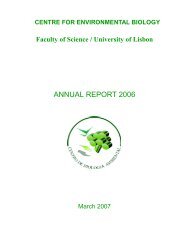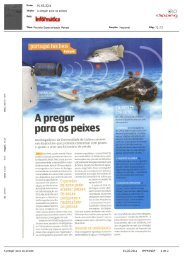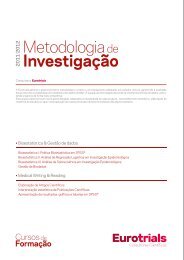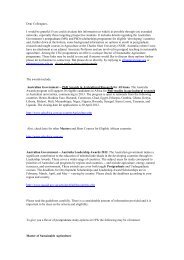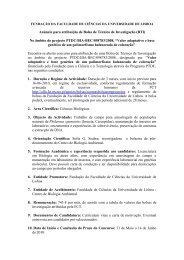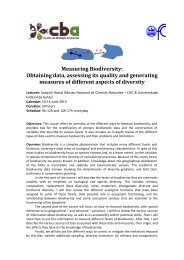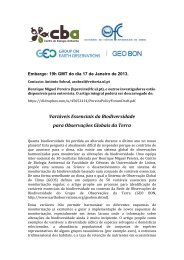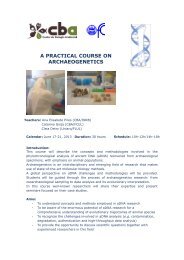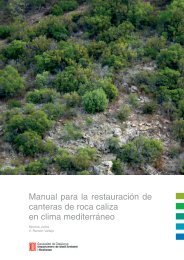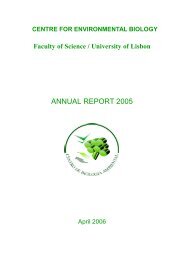European Red List of Vascular Plants - European Commission
European Red List of Vascular Plants - European Commission
European Red List of Vascular Plants - European Commission
You also want an ePaper? Increase the reach of your titles
YUMPU automatically turns print PDFs into web optimized ePapers that Google loves.
are declining. But more interestingly it needs to be noted<br />
that the population trend is unknown for 48.2% <strong>of</strong> the<br />
crop wild relatives, 36.7% <strong>of</strong> the policy plants and 18.6%<br />
<strong>of</strong> the aquatic plants.<br />
The main current threats emerging in the analysis were:<br />
Intensified livestock farming, recreational activities,<br />
tourism and urban development, wild plant collection,<br />
invasive alien species, natural system modifications and<br />
pollution.<br />
Conclusions and recommendations<br />
■■ Threatened <strong>European</strong> vascular plants require<br />
further conservation actions to improve their status.<br />
In particular: ensuring the adequate protection and<br />
management <strong>of</strong> important plant habitats, identifying<br />
hotspots <strong>of</strong> diversity that may then be subject to more<br />
active conservation, drawing up and implementing<br />
Species Action Plans for threatened species, improving<br />
land management policies, and revising national<br />
and <strong>European</strong> legislation, taking account <strong>of</strong> species<br />
identified as threatened where needed.<br />
■■ It is important to conserve both inter- and intraspecific<br />
genetic diversity to ensure that the full range<br />
<strong>of</strong> genetic diversity <strong>of</strong> a species is protected and in<br />
the case <strong>of</strong> CWR, available for utilization for crop<br />
improvement. For the in situ conservation <strong>of</strong> CWR<br />
genetic diversity, the establishment <strong>of</strong> a <strong>European</strong><br />
network <strong>of</strong> genetic reserves is needed. For all vascular<br />
plant species, the maximum range <strong>of</strong> ecogeographic<br />
diversity should be included in the <strong>European</strong> protected<br />
area network.<br />
■ ■ In situ conservation measures need to be<br />
accompanied by adequate ex situ maintenance in<br />
botanic gardens or gene bank collections. There is<br />
a need for systematic gap analysis <strong>of</strong> all threatened<br />
and priority species to ensure they are being actively<br />
conserved both in situ and ex situ.<br />
■■<br />
■■<br />
■■<br />
■■<br />
■■<br />
The knowledge base on <strong>European</strong> vascular plants<br />
needs to be expanded. The taxonomic coverage <strong>of</strong><br />
this <strong>Red</strong> <strong>List</strong> needs to be increased as only around 8%<br />
<strong>of</strong> Europe’s plant species have been assessed in this<br />
project. Species identified as Data Deficient should be<br />
a priority for fieldwork and research.<br />
A co-ordinated system <strong>of</strong> vascular plant recording<br />
and monitoring needs to be established in every<br />
<strong>European</strong> country to improve future assessments<br />
and assess the impact <strong>of</strong> conservation measures and<br />
future environmental change. This will improve our<br />
knowledge <strong>of</strong> population trends which is currently<br />
lacking for many <strong>European</strong> plant species.<br />
There is an urgent need for a coordinated <strong>European</strong><br />
approach to CWR conservation, given the growing<br />
problem <strong>of</strong> global food insecurity resulting from climate<br />
change and other threats (as well as the global interdependence<br />
<strong>of</strong> nations in terms <strong>of</strong> food security). The<br />
results <strong>of</strong> this initiative show that a significant proportion<br />
<strong>of</strong> the CWR species assessed are threatened or are likely<br />
to become threatened in the near future and that some<br />
crop complexes, such as the cultivated beets, brassicas,<br />
oat, lettuce and wheat are particularly at risk – these<br />
species should be subject to immediate conservation gap<br />
analysis and concerted in situ and ex situ actions.<br />
Biodiversity and agrobiodiversity conservation<br />
activities need to be integrated and coordinated.<br />
Conservation actions are <strong>of</strong>ten hindered through<br />
the unnecessary departmentalisation <strong>of</strong> <strong>European</strong><br />
biodiversity and agrobiodiversity communities<br />
leading to duplication <strong>of</strong> knowledge, poor integration<br />
<strong>of</strong> conservation action and limited implementation –<br />
working more closely together will itself yield better<br />
conservation outcomes.<br />
The network <strong>of</strong> <strong>European</strong> plant experts needs to<br />
be strengthened by providing training, improving<br />
communication, and mobilisation <strong>of</strong> financial resources.<br />
Specialist Groups play a vital role in this network and<br />
in the implementation <strong>of</strong> conservation measures.<br />
x



